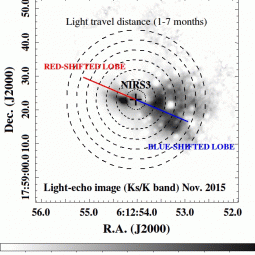An international scientific team led by Dr. Alessio Caratti o Garatti from the Dublin Institute for Advanced Studies (Ireland) for the first time observed and analyzed an outburst from a high-mass young stellar object that was caused by material accreting onto the star. The team combined mid-infrared and far-infrared images of SOFIA -- the Stratospheric Observatory for Infrared Astronomy -- with near-infrared images and spectra from other world-class observatories (Gemini Observatory, ESO/VLT, Calar Alto Observatory, and ESO/MPG) of a star named S255IR NIRS 3 (or NIRS 3 for short) that is 20 times more massive than our Sun. The University of Stuttgart coordinates the operation of the SOFIA observatory for the German partners.
With these data Caratti o Garatti and his colleagues confirmed that high mass stars may form like their less massive siblings, namely from collapsing interstellar gas and dust clouds, ultimately gathering the in-falling material through a so-called “accretion disk” of gas and dust surrounding the young star. Moreover, the new data provide proof of episodic accretion in young massive stars, previously observed during the formation of low mass stars: as the matter distribution in the accretion disk is not continuous but lumpy, disk fragments are occasionally ingested onto the growing star causing an eruption known as an accretion burst. Hence, the new observations and findings of Caratti o Garatti and his colleagues for NIRS 3 confirm that the formation of high mass stars can be considered as a scaled up version of the process by which low mass stars like our Sun are born. The main differences are that massive stars would form through larger accretion disks with much higher accretion rates and on much shorter time-scales (around 100,000 years instead of several million years).
The international team of astronomers from Ireland, Germany, Italy, UK, Chile, USA and Spain published their work in the November 14th issue of the Nature Physics journal.
NIRS 3 is 6,000 light years away, so astronomers on Earth are only now seeing an event that occurred well before the building of monuments like Stonehenge and the Pyramids. Previous observational data available from archives indicate that NIRS 3 is surrounded by a disk-like structure, probably an accretion disk, and is the source of a strong bipolar jet that is ejecting materially at hundreds of kilometers per second. Two lobes (cavities on either side of the source carved by the jets) are visible in the images as two infrared-bright nebulae. The new observations of NIRS 3 obtained from November 2015 to April 2016 showed a sudden increase in brightness of the central object and, subsequently, of the two nebulae. The brightening of the nebulae is due to tiny dust grains, which act as a mirror and reflect the light of the sudden-flare from the central protostar (causing the so-called light-echo). “Having in mind, that massive stars are fairly rare objects and the burst event only lasts a tiny fraction of a young star’s life, it was more likely that we would win a lottery than finding an outburst of a massive young star”, said Alessio Caratti o Garatti summarizing these findings.
Fortunately, flexible SOFIA observing time for a so-called Target of Opportunity was granted to Jochen Eislöffel (Thüringer Landessternwarte in Tautenburg) one of the co-authors of the Nature paper. The mid-infrared and far-infrared data of NIRS 3, obtained by SOFIA using the FORCAST (at 7.7, 11.1, 19.7, 31.5, and 37.1 microns) and FIFI-LS (at 65, 90, 140, and 160 microns) instruments, are crucial to derive fundamental parameters of the accretion burst such as the mass accreted during the event and the total energy being released by the burst. "We were very excited to see how much the spectral energy distribution -- especially in the mid and far infrared -- changed due to the burst”, Jochen Eislöffel, Principal Investigator of the SOFIA observations, said. Moreover, the SOFIA data provided crucial contributions to the wavelength coverage of NIRS 3, allowing astronomers to exclude other processes, such as varying obscuration, as the responsible for the luminosity variations.
Images taken a few months apart reveal the motion of the light-echo, and from the distance travelled by the light (moving at about 300,000 km/s), Caratti o Garatti and his colleagues could infer that the burst began in June 2015 (our time!). A detailed study of these objects has been so far hampered by the large quantity of dust and gas surrounding the massive protostars, and infrared observations are required to penetrate their dense envelopes. “At the moment only SOFIA can provide the necessary data in the mid- and far-infrared, which are crucial to derive the total luminosity of the young star NIRS 3 and the fundamental parameters of the accretion burst”, Alfred Krabbe, Director of the Deutsches SOFIA Institut at the University of Stuttgart, summarizes the potential of the flying observatory. He is also the Principal Investigator of FIFI-LS and co-author of the actual Nature publication. “In only nine months, the burst has produced the same amount of energy as the Sun in almost 100,000 years”, Krabbe continues. The astronomers could also work out how much matter must have fallen onto the young star to produce the outburst: roughly the equivalent of two giant planets like Jupiter. “Surprisingly, fireworks are seen not just at the end of the lives of massive stars, as supernovae, but also at their birth!”, concludes Caratti o Garatti.
Original Publication:
"Disk-mediated accretion burst in a high-mass young stellar object"
, A. Caratti o Garatti, B. Stecklum, R. Garcia Lopez, J. Eislöffel, T. P. Ray, A. Sanna, R. Cesaroni, C. M.Walmsley, R. D. Oudmaijer,W. J. deWit, L. Moscadelli, J. Greiner, A. Krabbe, C. Fischer, R. Klein and J. M. Ibañez , Nature Physics Journal Nov. 14 th 2016, DOI: 10.1038/NHPYS3942.
- An electronic version of the paper for personal use can be asked to the first author Alessio Caratti o Garatti ( alessio@cp.dias.ie ).
- Read access via Springer Nature Content Sharing Initiative



